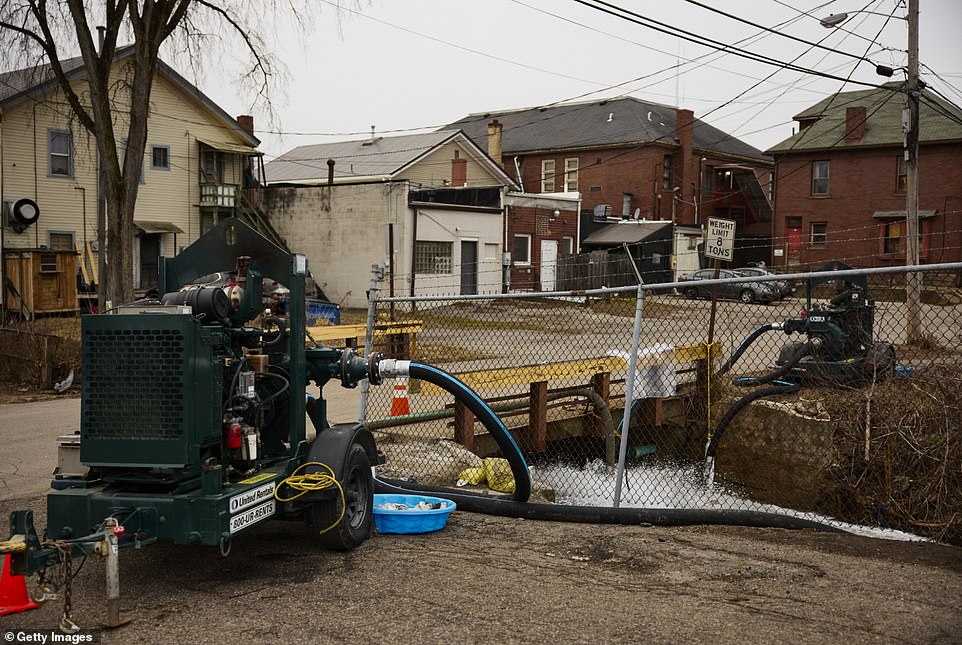Toxic Chemical Residue In Buildings Following Ohio Train Disaster

Table of Contents
Types of Toxic Chemicals and Their Potential Impacts
The derailment released a cocktail of hazardous substances, but vinyl chloride and butyl acrylate are of particular concern due to their volatility and potential for long-lasting contamination.
Vinyl Chloride: A Silent Threat
Vinyl chloride, a colorless gas used in the production of PVC plastic, is a known human carcinogen. Exposure can lead to various health problems, including liver damage, lung cancer, and brain tumors. Its volatility means it can easily penetrate building materials and linger in the air for extended periods.
- Volatile nature: Vinyl chloride readily evaporates, contaminating indoor air and potentially settling on surfaces.
- Detection and removal: Specialized air sampling and surface testing are crucial for detecting vinyl chloride contamination. Remediation often involves air filtration systems and thorough surface cleaning.
- Long-term health implications: Extensive research links long-term exposure to vinyl chloride with a significantly increased risk of various cancers. Further studies are crucial to fully understand the long-term health effects of the Ohio derailment exposure.
Butyl Acrylate: A Multi-pronged Hazard
Butyl acrylate, a colorless liquid used in paints, coatings, and adhesives, poses different but equally serious health risks. Exposure can cause eye, skin, and respiratory irritation, and in severe cases, can lead to more significant health issues. Its persistence in porous materials makes complete removal challenging.
- Persistence in building materials: Butyl acrylate can readily absorb into porous materials like wood, fabric, and drywall, making complete removal difficult and necessitating potentially extensive remediation.
- Removal difficulties: Effective remediation might require specialized cleaning methods, surface treatments, or even replacement of contaminated materials.
- Acute and chronic effects: Both acute (short-term) and chronic (long-term) health effects are associated with butyl acrylate exposure, ranging from irritation to more severe respiratory and systemic problems.
Other Released Chemicals: A Complex Mixture
The Ohio train derailment released other chemicals beyond vinyl chloride and butyl acrylate, further compounding the contamination risks. These include ethylene glycol monobutyl ether, ethylhexyl acrylate and others.
- Diverse health hazards: Each chemical carries its own set of health hazards, ranging from skin irritation to neurological effects. Detailed information on these chemicals and their health effects can be found through resources like the CDC and ATSDR.
- Synergistic effects: The combined exposure to multiple chemicals can lead to synergistic effects, where the combined impact is greater than the sum of individual effects, making accurate risk assessment particularly complex. Further research is needed to understand these potential interactions.
Assessing and Mitigating Building Contamination
Assessing and mitigating the contamination requires a multi-faceted approach involving rigorous testing, effective remediation strategies, and long-term monitoring.
Testing and Monitoring Procedures: A Crucial First Step
Thorough testing is essential to determine the extent of contamination in affected buildings. This involves various methodologies for air and surface testing.
- Air sampling: Air sampling using specialized equipment measures the concentration of volatile organic compounds (VOCs) like vinyl chloride in the air.
- Surface sampling (wipe samples): Wipe samples collect residue from surfaces to test for the presence of less volatile chemicals like butyl acrylate.
- Certified laboratories: Samples must be analyzed by certified laboratories to ensure accurate and reliable results, guiding the subsequent remediation efforts.
- Establishing safe occupancy levels: Once test results are obtained, experts need to establish safe occupancy levels, determining when it is safe for residents to return to their homes and businesses.
Remediation Strategies: Removing the Threat
Remediation strategies depend on the type and extent of contamination. Options include:
- Air filtration: High-efficiency particulate air (HEPA) filtration systems can remove airborne contaminants.
- Surface cleaning: Specialized cleaning methods and materials might be needed to remove chemical residues from surfaces.
- Material replacement: In severe cases, the replacement of contaminated materials (e.g., drywall, insulation) might be necessary.
- Specialized equipment: The process may require specialized equipment and trained professionals, adding to the cost and complexity.
Long-Term Monitoring: Ensuring Safety
Ongoing monitoring is crucial to ensure the effectiveness of remediation efforts and protect the health of occupants in the long term.
- Regular testing: Periodic testing helps to track contaminant levels and identify any potential resurgence of contamination.
- Transparent communication: Open and transparent communication with residents is essential to build trust and ensure cooperation.
- Long-term health impacts: It's crucial to acknowledge that long-term health impacts may arise, requiring continuous health monitoring and support for affected individuals.
Legal and Regulatory Aspects: Accountability and Support
The Ohio train derailment raises significant legal and regulatory questions surrounding liability, responsibility, and governmental response.
Liability and Responsibility: Who is Accountable?
Determining liability for the cleanup and compensation of affected residents is complex and involves multiple parties.
- Potential liable parties: The railroad company, contractors, and potentially government agencies could be held accountable.
- Environmental regulations: Applicable environmental regulations and potential legal actions under those laws will dictate the responsibility for cleanup and compensation.
Government Response and Support: Assessing Effectiveness
The government's response to the disaster has involved cleanup efforts, health monitoring, and support for affected communities.
- Cleanup initiatives: The effectiveness of the government's cleanup initiatives and their capacity to address the long-term environmental challenges remains under scrutiny.
- Health monitoring and compensation: Long-term health monitoring and fair compensation for affected residents are essential for demonstrating adequate governmental support.
- Shortcomings: Scrutinizing the government's response and identifying potential shortcomings is critical for improving future responses to similar disasters.
Conclusion
The toxic chemical residue from the Ohio train derailment poses a significant threat to the health and safety of those living and working in nearby buildings. Thorough testing, effective remediation, and ongoing monitoring are paramount to mitigate the risk. The long-term health consequences of this disaster remain uncertain, emphasizing the need for continued vigilance and comprehensive research. Demand answers, protect your family, and hold those responsible accountable. Stay informed about the ongoing situation, advocate for stronger environmental regulations, and demand swift and comprehensive action to address this public health crisis stemming from the toxic chemical residue following the Ohio train disaster.

Featured Posts
-
 Lw Ansf Alqwmu Tamlat Fy Dhkra Alastqlal
May 30, 2025
Lw Ansf Alqwmu Tamlat Fy Dhkra Alastqlal
May 30, 2025 -
 Understanding The New Us Visa Restrictions Related To Social Media
May 30, 2025
Understanding The New Us Visa Restrictions Related To Social Media
May 30, 2025 -
 Laurent Jacobelli Rn Son Role De Vice President A L Assemblee Nationale
May 30, 2025
Laurent Jacobelli Rn Son Role De Vice President A L Assemblee Nationale
May 30, 2025 -
 El Regreso De Andre Agassi Mas Alla Del Tenis Profesional
May 30, 2025
El Regreso De Andre Agassi Mas Alla Del Tenis Profesional
May 30, 2025 -
 Indiana Measles Outbreak Ends But Us Case Count At 1 046
May 30, 2025
Indiana Measles Outbreak Ends But Us Case Count At 1 046
May 30, 2025
Latest Posts
-
 Rising Covid 19 Cases The Whos Assessment Of A New Variant
May 31, 2025
Rising Covid 19 Cases The Whos Assessment Of A New Variant
May 31, 2025 -
 Darderi Falls To Shelton In Munich American Reaches Semifinals
May 31, 2025
Darderi Falls To Shelton In Munich American Reaches Semifinals
May 31, 2025 -
 Covid 19 Case Increase A New Variants Potential Role According To Who
May 31, 2025
Covid 19 Case Increase A New Variants Potential Role According To Who
May 31, 2025 -
 New Covid 19 Variant A Global Health Concern
May 31, 2025
New Covid 19 Variant A Global Health Concern
May 31, 2025 -
 Zverevs Comeback Victory Sends Him To Munich Semifinals
May 31, 2025
Zverevs Comeback Victory Sends Him To Munich Semifinals
May 31, 2025
